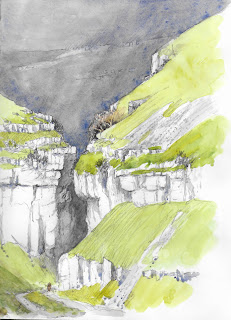When you begin a painting do you stop to consider your colour management or simply copy the colours in the original scene or photograph? Whether you are a serious artist intent on improving your work, or perhaps painting simply for enjoyment, it is so much more rewarding to create a composition where you can inject some of your own ideas to add interest.
In this watercolour of the Brecon Beacons I decided to create a much warmer feeling than was present in the scene on that particular day, and enhance the summery mood. Apart from the cobalt blue in the sky most of the scene embodies warmer colours, and after establishing the clouds with the blue I laid on permanent alizarin crimson over the lower sky. The blues on the mountains are French ultramarine with a touch of cadmium red added, resulting in a lovely warm purpley-blue. The greens on the fields have also been warmed up with touches of gamboge, and there are also some gamboge and cadmium orange fields to liven things up. In the foreground I dropped in some Indian red wet-in-wet to produce soft edges and when this was dry spattered Indian red and white gouache before finally scratching out reeds with a scalpel.
At the end of this week I am starting once more to do live workshops, this one at the excellent Sandpipers studio on the Wirral, while on 3rd April I start my first post-Covid course at the superb Caer Beris Manor hotel in Builth Wells. There are still places available on this course, so if you feel like getting out into beautiful landscapes again you will be very welcome. We will be sketching outside (hopefully painting as well if the weather is fine), and also working indoors in the ballroom which has plenty of room for us to keep apart from each other. Details are on my website Emphasis will be on injecting atmosphere into your landscapes and putting something of yourself into the subject.
Sadly we haven’t had much snow this winter, but with spring about to burst upon us let’s hope that this will herald better times for getting out and about with our paintboxes.




